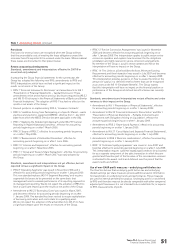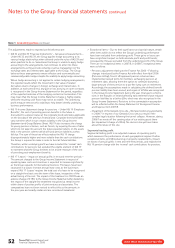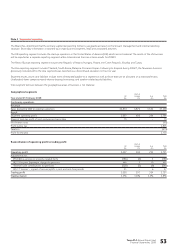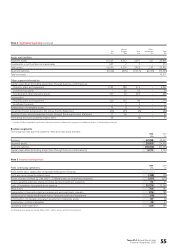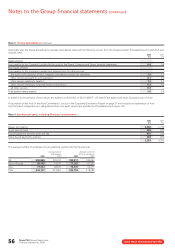Tesco 2008 Annual Report Download - page 54
Download and view the complete annual report
Please find page 54 of the 2008 Tesco annual report below. You can navigate through the pages in the report by either clicking on the pages listed below, or by using the keyword search tool below to find specific information within the annual report.
Tesco PLC Annual Report and
Financial Statements 2008
52
The adjustments made to reported profit before tax are:
> IAS 32 and IAS 39 ‘Financial Instruments’ – fair value remeasurements –
Under IAS 32 and IAS 39, the Group applies hedge accounting to its
various hedge relationships when allowed under the rules of IAS 39 and
when practical to do so. Sometimes the Group is unable to apply hedge
accounting to the arrangements, but continues to enter into these
arrangements as they provide certainty or active management of the
exchange rates and interest rates applicable to the Group. The Group
believes these arrangements remain effective and economically and
commerciallyviable hedges despite the inability to apply hedge accounting.
Where hedge accounting is not applied to certain hedging arrangements,
the reported results reflect the movement in fair value of related
derivatives due to changes in foreign exchange and interest rates. In
addition, at each period end, any gain or loss accruing on open contracts
is recognised in the Group Income Statement for the period, regardless
of the expected outcome of the hedging contract on termination. This
may mean that the Group Income Statement charge is highly volatile,
whilst the resulting cash flows may not be as volatile. The underlying
profit measure removes this volatility to help better identify underlying
business performance.
> IAS 19 Income Statement charge for pensions – Under IAS 19 ‘Employee
Benefits’, the cost of providing pension benefits in the future is
discounted to a present value at the corporate bond yield rates applicable
on the last day of the previous financial year. Corporate bond yield rates
vary over time which in turn creates volatility in the Group Income
Statement and Group Balance Sheet. IAS 19 also increases the charge
for young pension schemes, such as Tesco’s, by requiring the use of rates
which do not take into account the future expected returns on the assets
held in the pension scheme which will fund pension liabilities as they
fall due. The sum of these two effects makes the IAS 19 charge
disproportionately higher and more volatile than the cash contributions
the Group is required to make in order to fund all future liabilities.
Therefore, within underlying profit we have included the ‘normal’ cash
contributions for pensions but excluded the volatile element of IAS 19
to represent what the Group believes to be a fairer measure of the cost
of providing post-employment benefits.
> IAS 17 ‘Leases’ – impact of annual uplifts in rent and rent-free periods –
The amount charged to the Group Income Statement in respect of
operating lease costs and incentives is expected to increase significantly
as the Group expands its International business. The leases have been
structured in a way to increase annual lease costs as the businesses
expand. IAS 17 ‘Leases’ requires the total cost of a lease to be recognised
on a straight-line basis over the term of the lease, irrespective of the
actual timing of the cost. The impact of this treatment in 2007/8 was an
adverse charge of £18m to the Group Income Statement after deducting
the impact of the straight-line treatment recognised as rental income
within share of post-tax profits of joint ventures and associates. The
comparatives have not been revised to reflect this as the amounts in
the prior year are broadly similar and are considered immaterial.
> Exceptional items – Due to their significance and special nature, certain
other items which do not reflect the Group’s underlying performance
have been excluded from underlying profit. These gains or losses can
have a significant impact on both absolute profit and profit trends;
consequently, they are excluded from the underlying profit of the Group.
There are no exceptional items in 2007/8. In 2006/7, exceptional items
were as follows:
– Pensions adjustment relating to the Finance Act 2006 – Following
changes introduced by the Finance Act with effect from April 2006
(Pensions A-Day), Tesco’s UK approved pension schemes have
implemented revised terms for members exchanging pension at
retirement date, allowing them the option to commute (convert) a
larger amount of their pension to a tax-free lump sum on retirement.
Accordingly, the assumptions made in calculating the defined benefit
pension liability have been revised, and a gain of £250m was recognised
in the Group Income Statement during the year. Changes to scheme
rules in the Republic of Ireland affecting early retirement have reduced
pension liabilities by a further £8m, which was also recognised in the
Group Income Statement. Revisions to the commutation assumption
will be reflected within the Group Statement of Recognised Income
and Expense from 2007/8.
– Impairment of the Gerrards Cross site – We faced continuing uncertainty
in 2006/7 in respect of our Gerrards Cross site as a result of the
complex legal situation following the tunnel collapse. However, during
2006/7 we wrote off the carrying value of our existing asset there
(an impairment charge of £35m). No decision has yet been taken
about the future of this site.
Segmental trading profit
Segmental trading profit is an adjusted measure of operating profit,
which measures the performance of each geographical segment before
exceptional items, profit/(loss) arising on property-related items, impact
on leases of annual uplifts in rent and rent-free periods, and replaces the
IAS 19 pension charge with the ‘normal’ cash contributions for pensions.
www.tesco.com/annualreport08
Notes to the Group financial statements continued
Note 1 Accounting policies continued











